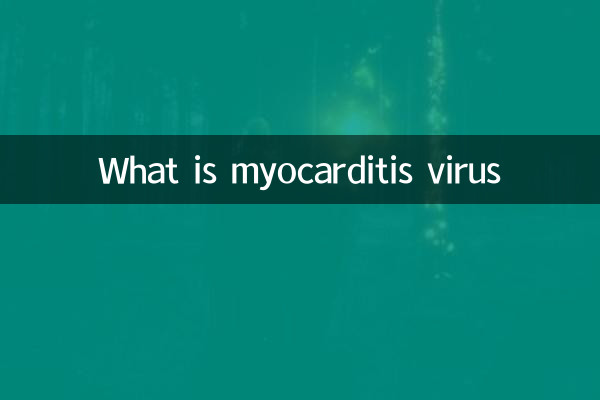What virus is myocarditis?
Recently, topics related to myocarditis have sparked widespread discussion on social media and health forums. With the high incidence of respiratory diseases in winter, the number of viral myocarditis has also increased. This article will combine the hot contents of the past 10 days to analyze the pathogenic viruses, symptoms and preventive measures of myocarditis.
1. Common viral pathogens of myocarditis

Myocarditis refers to an inflammatory disease of the myocardium, which is mostly caused by viral infection. The following are the most discussed pathogenic virus statistics in the medical field in the past 10 days:
| Virus Type | Percentage (recent data) | High incidence season |
|---|---|---|
| Coxsach Group B virus | 35-40% | All year round (mainly summer and autumn) |
| Adenovirus | 20-25% | Winter and spring |
| Influenza virus (type A/type B) | 15-18% | winter |
| Coronavirus (SARS-CoV-2) | 8-12% | annual |
| EB virus | 5-8% | annual |
2. Analysis of the characteristics of recent hot cases
According to the public medical report from December 1 to 10:
| Age group | Major pathogenic viruses | Typical Symptoms |
|---|---|---|
| Children (3-12 years old) | Adenovirus, Coxsackie virus | Chest tightness and fatigue after fever |
| Teenagers (13-25 years old) | Influenza virus, EB virus | Palpitations and chest pain after exercise |
| Middle-aged and young people (26-45 years old) | Coronavirus, flu virus | Difficulty in breathing, arrhythmia |
| Elderly (over 65 years old) | Influenza virus, coronavirus | Edema, fainting |
III. Dissemination and prevention of viral myocarditis
Recently, the Centers for Disease Control and Prevention in many places issued reminders that viral myocarditis is mainly transmitted through the following channels:
1.Respiratory transmission: Influenza viruses, adenoviruses, etc. are transmitted through droplets
2.Gastrointestinal transmission: Coxsackie virus is transmitted through fecal-oral route
3.Blood transmission: For example, EB virus can be transmitted through blood transfusion
4. Latest expert suggestions (updated in December)
1. Influenza vaccination and COVID-19 vaccine can reduce the risk of severe myocarditis
2. Avoid strenuous exercise for at least 2 weeks after a cold
3. If there is continuous palpitations and chest tightness, you should do an electrocardiogram in time
4. Keep drinking water at least 1500ml per day in winter
5. Enhance immunity by ensuring 7-8 hours of sleep
5. Timeline of recent typical cases
| date | area | Case characteristics |
|---|---|---|
| December 3 | Beijing | A 23-year-old man who plays ball after flu causes severe myocarditis |
| December 5 | Shanghai | A 35-year-old woman who suddenly suffered cardiogenic shock after rehabilitation of COVID-19 |
| December 8 | Guangzhou | Adenovirus infection and myocardial injury in 7-year-old children |
Summarize:Recent clinical data show that coxsackie virus and adenovirus account for the highest proportion among viral myocarditis cases, but myocardial injuries caused by influenza virus and the new coronavirus also need to be taken seriously. The public is specially reminded to take good protection during the peak season of respiratory diseases and seek medical treatment in a timely manner when related symptoms occur.

check the details

check the details